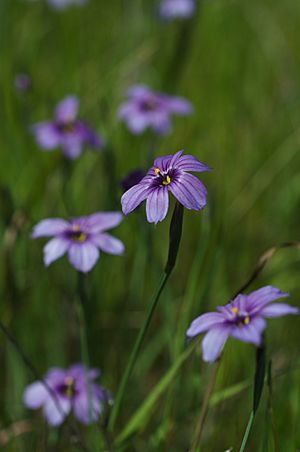Western blue-eyed grass facts for kids
Quick facts for kids Western blue-eyed grass |
|
|---|---|
 |
|
| Scientific classification | |
| Genus: |
Sisyrinchium
|
| Species: |
bellum
|
| Synonyms | |
|
|
Western blue-eyed grass, also known as Californian blue-eyed grass, is a common plant found in California and Oregon. Its scientific name is Sisyrinchium bellum. You can see it growing west of the Sierra Nevada mountains, and its range goes all the way down to Baja California in Mexico.
This plant is a perennial. This means it lives for more than two years. It likes to grow in open, grassy areas where there is some moisture. You can also find it in woodlands and at high altitudes, up to about 2,400 meters (7,900 feet). In places where it grows a lot, people often just call it "blue-eyed grass."
What Does Western Blue-Eyed Grass Look Like?
The stems of western blue-eyed grass can grow up to 60 centimeters (about 2 feet) long. However, they are often shorter than that. Its leaves look like grass and grow in clumps.
The flowers are about 1 to 2 centimeters (0.4 to 0.8 inches) wide. They are usually purplish-blue, but the color can change. Some flowers are a true blue, while others are more purple. Occasionally, you might even find plants with white flowers.
This plant blooms from March to July. It flowers the most in April. After it finishes flowering, the plant dies back to the ground. It then rests during the summer months. Its seeds are very tiny, weighing only about 1 to 4 milligrams when dry.
Growing and Caring for This Plant
Western blue-eyed grass likes a bit of moisture. It also needs soil that drains well, so water doesn't sit around its roots. However, it can handle dry summers once it's grown.
You can grow new plants from seeds. This plant also spreads its own seeds naturally. Another way to grow it is by dividing its rhizomes. Rhizomes are like underground stems. You can even root the flower stems to grow new plants!
This plant is quite tough. It can handle cold temperatures down to about -6 degrees Celsius (20 degrees Fahrenheit).
Traditional Uses of Blue-Eyed Grass
Long ago, the Ohlone people used western blue-eyed grass. They made a special drink from the roots and leaves. They used this drink to help with stomach pain and problems like indigestion.
Other Native American groups also used this plant for similar purposes. It was an important part of their traditional medicine.


